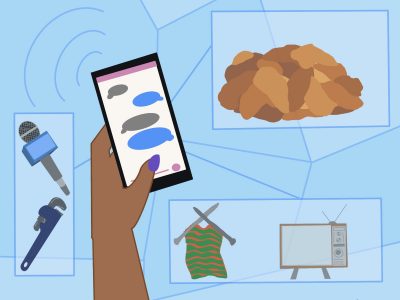Crochet a unique top, make a rug for your room or learn to belly dance — these are all things social media platforms can spur its users into trying. Of course, thoughts on how these platforms can impact society negatively are prevalent today, but what about their positive effects?
For one thing, I believe it is important to acknowledge how nowadays, social media has led to users’ increased experimentation with new hobbies. Though YouTube has had tutorial videos a click away for some time now, newer applications like TikTok have become a home for hobbies.
The COVID-19 pandemic was the turning point for this kind of media.
Considering many people had no clue what to do with themselves during lockdown, they became more receptive to picking up something new. Usually, school, work and other responsibilities would discourage most from spending their free time practicing calligraphy, but the pandemic largely removed these inhibitors.
Despite the fact that acquiring new skills can keep the brain sharp, it is difficult to prioritize this whilst living in a capitalistic society. When users are done with their long to-do lists, they simply want rest.
Once the pandemic disrupted any sort of routine, users still had the lingering need to feel productive. Time-consuming hobbies, like crocheting, became very popular.

Coupled with the TikTok explosion, when the lockdown prompted a rise in the app’s popularity, users created pages dedicated to their creative processes. As a result, others felt inspired while they had time on their hands.
Learning any skill may seem intimidating, but the application has given viewers easy access to information. At the same time, most videos are motivating because they make the end goal seem more attainable. All viewers have to do is start somewhere.
Individuals were feeling particularly depressed when the pandemic changed their lives so drastically, and these pastimes became coping mechanisms. Even if you are not into any hobbies I previously mentioned, these are only a few examples of many. In reality, there is truly something for everyone when it comes to hobbies on these platforms.
Especially on TikTok, where your “For You” page caters your feed to your interests, users will come across skills they are more likely to enjoy. For instance, I personally became involved with videos about new age spirituality circulating the application and picked up tarot reading as a hobby.
In doing so, I realized just how important stimulating my brain is. One too many lazy days had gotten to me, but keeping busy made me feel fulfilled. In general, people are creatures of habit and social media, at that time, was living proof. It showed how pursuing hobbies replaced our pre-pandemic routines.
Now, users continue to pursue those hobbies they picked up during lockdown, creating pages of their own to share what they have learned. It has become a wholesome aspect of social media culture.
Not so popular amongst Generation Z, Pinterest has a reputation for its creative content. From crafts to do with little ones to step-by-step sewing instructions, it is certainly a vast pool of guidance.
The main difference is that it is not integrated with our typical social content. Uniquely, TikTok’s main page allows you to see friends’ posts, funny posts and creative posts all in a few scrolls. Pinterest lacks this versatility, providing an explanation for why TikTok has assumed a special role in sharing hobbies with its users.
It is argued that phones have completely replaced books in capturing our attention but actually, I have recently made it onto “BookTok.” Here, creators share their book recommendations and encourage users to start reading. Evidently, social media’s hobby-sharing has made it so even reading — a pastime the internet seems to have replaced — can be taken up by more people.
Visiting the platform every day, I realize there may be some misconceptions on what users are actually consuming. Yes, some of it may be damaging but that is all based on what side of it you choose to be on. I, for one, have found it very useful to use the “Not interested” option when harmful content surfaces on my “For You” page.
My point is, like everything, we can focus on the negative aspects of social media but positives are undeniably present. Ultimately, hearing both sides of the story is the only way to get the full picture.



















































































































